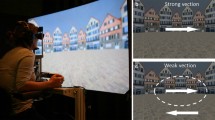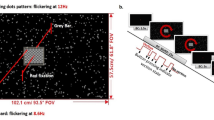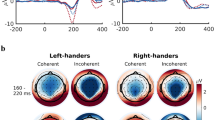Abstract
Visually induced motion sickness (VIMS) is triggered in susceptible individuals by stationary viewing of moving visual scenes. VIMS is often preceded by an illusion of self-motion (vection) and/or by inappropriate optokinetic nystagmus (OKN) responses associated with increased activity in the human motion-sensitive middle temporal area (MT+). Neuroimaging studies have reported predominant right hemispheric activation in MT+ during both vection and OKN, suggesting that VIMS may result from desynchronization of activity between left and right MT+ cortices. However, this possibility has not been directly tested. To this end, we presented VIMS-free and VIMS-inducing movies in that order while measuring the temporal correlations between corresponding left and right visual cortices (including MT+) using functional magnetic resonance imaging. The inter-hemispheric correlation was reduced significantly during the viewing of the VIMS-inducing movie compared to the control VIMS-free movie in the MT+ of subjects reporting VIMS, but not in insusceptible subjects. In contrast, there were no significant inter-hemispheric differences within VIMS-free or VIMS-inducing movie exposure for visual area V1, V2, V3, V3A or V7. Our findings provide the first evidence for an association between asynchronous bilateral MT+ activation and VIMS. Desynchronization of left and right MT+ regions may reflect hemispheric asymmetry in the activities of functional networks involved in eye movement control, vection perception and/or postural control.







Similar content being viewed by others
References
Bates D, Maechler M, Bolker BM, Walker S (2014) lme4: Linear mixed-effects models using eigen and S4. Submitted to J Stat Softw. arxiv:1406.5823
Bos JE, Bles W (1998) Modelling motion sickness and subjective vertical mismatch detailed for vertical motions. Brain Res Bull 47(5):537–542
Brandt T, Bartenstein P, Janek A, Dieterich M (1998) Reciprocal inhibitory visual-vestibular interaction. Visual motion stimulation deactivates the parieto-insular vestibular cortex. Brain 121(Pt 9):1749–1758
Bullmore E, Long C, Suckling J, Fadili J, Calvert G, Zelaya F, Brammer M (2001) Colored noise and computational inference in neurophysiological (fMRI) time series analysis: resampling methods in time and wavelet domains. Hum Brain Mapp 12(2):61–78
Cheung BSK, Howard IP, Money KE (1991) Visually-induced sickness in normal and bilateral labyrinthine-defective subjects. Aviat Space Environ Med 62:527–531
Cox RW (1996) AFNI: software for analysis and visualization of functional magnetic resonance neuroimages. Comput Biomed Res 29:162–173
De Rosario-Martinez H (2013) phia: Post-hoc interaction analysis. R package version 0.1-3
De Yoe EA, Carman GJ, Bandettini P, Glickman S, Wieser J, Cox R, Miller D, Neitz J (1996) Mapping striate and extrastriate visual areas in human cerebral cortex. Proc Nat Acad Sci (USA) 93:2382–2386
Dieterich M, Bucher SF, Seelos KC, Brandt T (1998) Horizontal or vertical optokinetic stimulation activates visual motion-sensitive, ocular motor and vestibular cortex areas with right hemispheric dominance. An fMRI study. Brain 121(8):1479–1495
Dieterich M, Bense S, Stephan T, Yousry TA, Brandt T (2003) fMRI signal increases and decreases in cortical areas during small-field optokinetic stimulation and central fixation. Exp Brain Res 148(1):117–127
Ebenholtz S (1992) Motion sickness and oculomotor systems in virtual environments. Presence Teleoper Virtual Environ 1(3):302–305
Ebenholtz SM, Cohen MM, Linder BJ (1994) The possible role of nystagmus in motion sickness: a hypothesis. Aviat Space Environ Med 65(11):1032–1035
Ellis SR (1991) Nature and origins of virtual environments: a bibliographical essay. Comput Syst Eng 2(4):321–347
Engel SA, Rumelhart DE, Wandell BA, Lee AT, Glover GH, Chichilnisky EJ, Shadlen MN (1994) fMRI of human visual cortex. Nature 369:525
Flanagan MB, May JG, Dobie TG (2004) The role of vection, eye movements and postural instability in the etiology of motion sickness. J Vestib Res 14(4):335–346
Golding JF (2006) Motion sickness susceptibility. Auton Neurosci 129(1):67–76
Griffin MJ (1990) Handbook of human vibration. Academic Press, London
Hasson U, Avidan G, Gelbard H (2009) Shared and idiosyncratic cortical activation patterns in autism revealed under continuous real-life viewing conditions. Autism Res 2:220–231
Hettinger LJ, Berbaum KS, Kennedy RS, Dunlap WP, Nolan MD (1990) Vection and simulator sickness. Mil Psychol 2(3):171–181
Huk AC, Dougherty RF, Heeger DJ (2002) Retinotopy and functional subdivision of human areas MT and MST. J Neurosci 22(16):7195–7205
Kennedy RS, Graybiel A, McDonough RC, Beekwith FD (1968) Symptomatology under storm conditions in the North Atlantic in control subjects and in persons with bilateral labyrinthine defects. Acta-Oto-Laryngol 66:533–540
Kennedy RS, Fowlkes J, Lilienthal M (1993a) Postural and performance changes following exposures to flight simulators. Aviat Space Environ Med 64(10):912–920
Kennedy RS, Lane NE, Berbaum KS, Lilienthal MG (1993b) Simulator sickness questionnaire: an enhanced method for quantifying simulator sickness. Int J Aviat Psychol 3(3):203–220
Kennedy RS, Drexler J, Kennedy RC (2010) Research in visually induced motion sickness. Appl Ergon 41(4):494–503
Kleinschmidt A, Thilo KV, Büchel C, Gresty MA, Bronstein AM, Frackowiak RS (2002) Neural correlates of visual-motion perception as object-or self-motion. Neuroimage 16:873–882
Konen CS, Kleiser R, Seitz RJ, Bremmer F (2005) An fMRI study of optokinetic nystagmus and smooth-pursuit eye movements in humans. Exp Brain Res 165(2):203–216
Kovacs G, Raabe M, Greenlee MW (2008) Neural correlates of visually induced self-motion illusion in depth. Cereb Cortex 18(8):1779–1787
Napadow V, Li A, Loggia ML, Kim J, Schalock PC, Lerner E, Tran TN, Ring J, Rosen BR, Kaptchuk TJ, Pfab F (2012) The brain circuitry underlying the temporal evolution of nausea in humans. Cereb Cortex 23(4):806–813
Napadow V, Sheehan J, Kim J, Dassatti A, Thurler AH, Surjanhata B, Vangel M, Makris N, Schaechter JD, Kuo B (2013) Brain white matter microstructure is associated with susceptibility to motion-induced nausea. Neurogastroenterol Motil 25(5):448-e303
Nir Y, Mukamel R, Dinstein I, Privman E, Harel M, Fisch L, Malach R (2008) Interhemispheric correlations of slow spontaneous neuronal fluctuations revealed in human sensory cortex. Nat Neurosci 11(9):1100–1108
Oman CM (1990) Motion sickness: a synthesis and evaluation of the sensory conflict theory. Can J Physiol Pharmacol 68(2):294–303
R Development Core Team (2013) R: A Language and Environment for Statistical Computing. Vienna: R Foundation for Statistical Computing; R Foundation for Statistical Computing. ISBN 3–900051–07–0. http://www.R-project.org/
Reason JT (1978) Motion sickness adaptation: a neural mismatch model. J R Soc Med 71(11):819–829
Reason JT, Brand JJ (1975) Motion sickness. Academic Press, London
Riccio GE, Stoffregen TA (1991) An ecological theory of motion sickness and postural instability. Ecol Psychol 3:195–240
Sereno MI, Dale AM, Reppas JB, Kwong KK, Belliveau JW, Brady TJ, Rosen BR, Tootell RB (1995) Borders of multiple visual areas in humans revealed by functional magnetic resonance imaging. Science 268:889–893
Shupak A, Gordon CR (2006) Motion sickness: advances in pathogenesis, prediction, prevention, and treatment. Aviat Space Environ Med 77(12):1213–1223
Smith AT, Wall MB, Thilo KV (2012) Vestibular inputs to human motion-sensitive visual cortex. Cereb Cortex 22(5):1068–1077
Sterzer P, Kleinschmidt A (2010) Anterior insula activations in perceptual paradigms: often observed but barely understood. Brain Struct Funct 214(5–6):611–622
Wall MB, Smith AT (2008) The representation of egomotion in the human brain. Curr Biol 18:191–194
Yamamoto H, Ban H, Fukunaga M, Umeda M, Tanaka C, Ejima Y (2008) Large- and small-scale functional organization of visual field representation in the human visual cortex. In: Portocello TA, Velloti RB (eds) Visual cortex: new research. Nova Science Publisher, New York, pp 195–226
Yamamoto T, Yamamoto H, Mano H, Umeda M, Tanaka C, Kawano K (2009) A new fMRI method for subdividing the human middle temporal complex into retinotopic areas. Neurosci Res 65:S173
Yamamoto H, Fukunaga M, Takahashi S, Mano H, Tanaka C, Umeda M, Ejima Y (2012) Inconsistency and uncertainty of the human visual area loci following surface-based registration: probability and entropy maps. Hum Brain Mapp 33:121–129
Zar JH (2009) Biostatistical Analysis, 5th edn. Pearson Education International, London
Acknowledgments
We thank Yoshimichi Ejima and Shigeko Takahashi for their helpful comments. We also thank anonymous reviewers for their constructive comments and suggestions. This study was supported by a Grant-in-Aid for Scientific Research on Innovative Areas “Shitsukan” (23135517, 25135720) from the Ministry of Education, Culture, Sports, Science and Technology of Japan and Grants-in-Aid for Scientific Research (22530793) from the Japan Society for the Promotion of Science (JSPS) to H. Yamamoto.
Author information
Authors and Affiliations
Corresponding author
Electronic supplementary material
Below is the link to the electronic supplementary material.
Supplementary material 1 (MOV 7773 kb)
Supplementary material 2 (MOV 7906 kb)
Rights and permissions
About this article
Cite this article
Miyazaki, J., Yamamoto, H., Ichimura, Y. et al. Inter-hemispheric desynchronization of the human MT+ during visually induced motion sickness. Exp Brain Res 233, 2421–2431 (2015). https://doi.org/10.1007/s00221-015-4312-y
Received:
Accepted:
Published:
Issue Date:
DOI: https://doi.org/10.1007/s00221-015-4312-y




